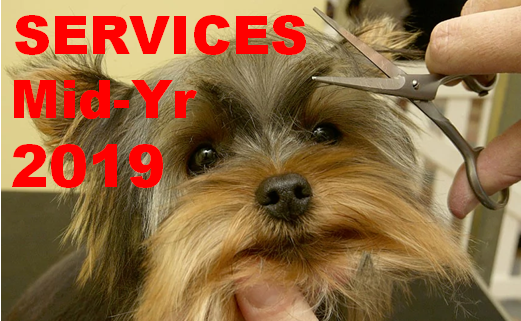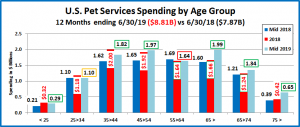U.S. Pet Services Spending (Non-Vet) $8.81B (↑$0.95B): 2019 Mid-Year Update
The US BLS just released their Mid-Year Update of the Consumer Expenditure Survey covering the period 7/1/2018 to 6/30/2019. In our analysis of Pet Supplies Spending we saw a 24 month lift come to an end. Tariffs drove prices up and Spending turned sharply down across virtually every demographic segment in the 1st half of 2019 . Pet Food Spending also turned down, but in the 2nd half of 2018, in reaction to an FDA warning on grain free dog food. Now we turn our attention to Pet Services. The Mid-year numbers show that spending in this segment was $8.81B, up $0.945B (+12.0%) from the previous year. This segment is known for consistent, albeit small increments of growth. In 2018 that changed. The 1st half saw a $1.1B increase followed with an additional $0.85 lift in the 2nd half. This annual $1.95B increase was by far the biggest $ increase in history. In the 1st half of 2019, Services spending plateaued, but at this unprecedented, elevated level. This deserves a closer look. First, we’ll review recent Services spending history since 2013.
Here are the 2019 Mid-Year Specifics:
Mid-Year 2019: $8.81B; ↑$0.945B (+12.0%) vs Mid-Yr 2018
Jul > Dec 2018: ↑$0.85B
Jan > Jun 2019: ↑$0.09B
Pet Services is by far the smallest industry segment. However, except for 2010 and 2011, the period immediately following the Great Recession, it had consistent annual growth from 2000 through 2016. Spending in Food and Supplies have been on a roller coaster ride during that period. Services Spending more than tripled from 2000 to 2016, with an average annual growth rate of 7.6%. Spending in the Services Segment is the most discretionary in the industry and is more strongly skewed towards higher income households. Prior to the great recession, the inflation rate averaged 3.9% with no negative impact. The recession affected every industry segment, including Services. Consumers became more value conscious, especially in terms of discretionary spending. Services saw a slight drop in spending in both 2010 and 2011, but then the inflation rate fell to the 2+% range and the segment returned to more “normal” spending behavior. In mid-2016 inflation dropped below 2% and continued down to 1.1% by the end of 2017. This was primarily due to increased competition from free standing businesses but also an increase in the number of Pet Stores and Veterinary Clinics offering pet services. While prices still went up slightly, there were deals to be had and consumers shopped for the best price. There was no decrease in purchase frequency. Consumers just paid less so spending fell slightly. In the 2nd half of 2017 spending turned up again. More Consumers began to take advantage of the value and convenience of the increased number of outlets offering Services. This deeper market penetration caused Services Spending to take off in 2018, up $1.95B, by far the biggest annual increase in history. Prices turned up again in the first half of 2019, increasing 2.8% from 2018. However, Services essentially “held their ground” as spending inched up $0.09B. With an annual growth rate of 8.2% since 2000, Services have become more prominent in the Industry.
Let’s take a closer look at some spending demographics – Age and Income.
In the graphs that follow we will compare spending for the Mid-year 12 months ending 6/30/19 to the previous period ending 6/30/18. In our graphs we will also include the 2018 yearend $pending. This will also allow you to see the spending changes in the 2nd half of 2018 and the 1st half of 2019.
The first graph is for Income, the single most important factor in increased Pet Spending, especially in Services.
Here’s how you get the change for each half using the Over $70K group as an example:
Mid-yr Total Spending Change: $6.43B – $5.62B = Up $0.81B (Note green outline = increase; red outline = decrease)
- 2nd half of 2018: Subtract Mid-18 ($5.62B) from Total 2018 ($6.31B) = Spending was up $0.69B in 2nd half of 2018.
- 1st half of 2019: Subtract Total 2018 ($6.31B) from Mid-19 ($6.43B) = Spending was up $0.12B in 1st half of 2019.
- Both the Over and Under $70K groups had a 12-month spending increase. However, Over $70K was responsible for 86% of the $0.94B national lift. The Under $70K group decreased spending in the 1st half of 2019 so their overall increase was produced solely by a lift in the 2nd half of 2018.
- The individual groups over $70K all showed growth in both halves, but it was minimal in the 1st half of 2019. The Over $100K groups were responsible for 81% of the total Services increase.
- The lower income, $30>50K group had a spending pattern similar to the highest income groups but their percentage increase was more. Spending was up 47%. The lift in this group was driven by Retirees (Avg Income: $42K) as they chose to fulfill their real need for Pet Services. This group is the only reason Under $70K registered an increase.
- Spending in the Under $30K group was essentially flat. The lower middle income, $50>70K group had the biggest decrease and it came from a big drop in the 1st half of 2019, following a small lift at the end of 2018.
- Income is the biggest factor in choosing the discretionary convenience of Pet Services. However, we can’t ignore “need” as was demonstrated by the retiree driven performance of the $30>50K group.
Now, Services’ Spending by Age Group.
- The spending lift in both halves by the 65+ yr olds and the highest income 45>54 age group mirrors what see saw in the income category. Plus, their major lifts came in different halves.
- The 55>64 yr old Boomers had the only overall decrease. It was minor and spending was flat in the 1st half of 2019.
- All groups under 45 had the same pattern with a spending lift in the last half of 2018, followed by a drop in the first half of 2019. The size of the drop grew with age and spending. The 25>34 yr olds were flat. The others spent more.
- It’s obvious that the biggest positive movement in Services Spending in the 1st half of 2019 came from oldest groups.
Now let’s look at what is happening in Pet Services spending at the start of 2019 across the whole range of demographics. In our final chart we will list the biggest $ moves, up and down by individual segments in 11 demographic categories. Remember, the lift in the 1st half of 2019 was $0.09B, much less than the $0.85B in the 2nd half of 2018.
The first thing that is readily apparent is that the $ changes from winners and losers in each category tend to cancel each other out. This is similar to a pattern that we saw in Food, which also had a minor increase in spending during the 1st half of 2019. The $0.09B increase in Pet Services came from 46 of 80 demographic segments (58%) spending more, just 2 more than the 44 in Pet Food.
The positive impact on Services spending in the 1st half of 2019 by older Americans is obvious from theses 6 winners:
- 65+ Yrs
- $30>49K
- Retired
- No Earner, Single
- Homeowner w/o Mtge
- Silent/Greatest Generations
Like the Food and Supplies segments, Single CUs also had a good start to 2019 in Services spending, winning in 3 demographic categories. However, for Services, the “driver” was No Earner, Singles.
It wasn’t all older groups as 3 “usual” winners came to the top – White, Not Hispanic, BA/BS Degree and Suburban.
On the “losing” side we see evidence of the slight downturn in spending by the younger groups in the performance of these segments:
- 35>44 Yrs
- Gen X
- 3 People
- Married, Oldest Child <6
- Renter
- Central City
We should also note that Gen X (-$0.06B) barely beat out Millennial/Gen Z (-0.057B) for the “losing” spot so the decline was basically universal in the youngest groups. 2 Earner CUs are also more common in these groups.
In 2018 the Services segment reached a new level of prominence in the Pet Industry. However, in 2019 growth seems to be slowing. How did we get here and what comes next?
We have noted that by 2017 the number of outlets offering Pet Services had radically increased. This created a highly competitive market and the inflation rate dropped to near record lows. Value conscious consumers saw that deals were available, and they took advantage of the situation. However, they didn’t increase the frequency of purchase. They just paid less. This drove overall Pet Services spending down in the 1st half of 2017. The segment started to recover in the 2nd half but not enough to prevent the first annual decrease in Pet Services spending since 2011. However, it was a start. In 2018, more consumers started to recognize the convenience offered by more outlets. The latest big food upgrade was also winding down. The result was that Services started a deeper penetration into the market, especially in the younger groups. The <45 groups spent $1.47B more on Services in 2018, 74% of the total $1.95B increase in the segment. As such, a slight downturn in 2019 is not unexpected. They may just have been value shopping. However, the oldest groups did seize the opportunity. They have a real need for Pet Services. Now they are convenient and more affordable.
Will this continue? What can we expect in the 2nd half of 2019? We can’t say for sure, but inflation could be a factor. In the 1st half of 2019 Services prices were up 2.9% vs 2018. This also may have contributed to the reduced spending by some segments. However, the rate slowed to +2.2% in the 2nd half. This is historically a more typical inflation rate for this segment. It probably signals a return to slow, consistent growth for Services. We’ll see when the full year spending data for 2019 is released in September.







